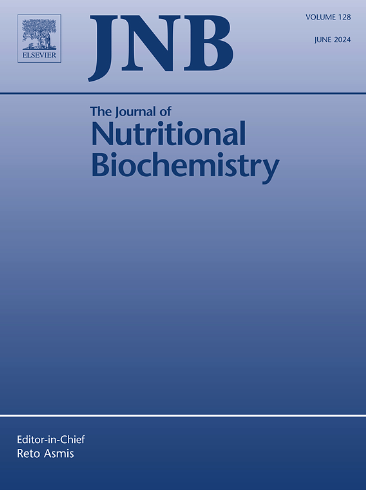Maternal obesity changes the small intestine endocannabinoid system and fecal metabolites of weanling rats associated with reduced intestinal permeability and impaired glucose homeostasis
IF 4.8
2区 医学
Q1 BIOCHEMISTRY & MOLECULAR BIOLOGY
引用次数: 0
Abstract
The small intestine, including the endocannabinoid system (ECS), regulates the energy homeostasis. If maternal obesity modifies the intestinal ECS of the offspring favoring metabolic disorders throughout life is unexplored. Regardless maternal insults, overaction of the ECS has been related to obesity, mainly via type 1 cannabinoid receptor (CB1) signaling, while type 2 cannabinoid receptor (CB2) signaling and the endocannabinoid-like compounds, such as oleoylethanolamide (OEA) and palmitoylethanolamide (PEA), have been associated with anti-inflammatory effects. We hypothesized that maternal obesity changes the ECS in the small intestine of weanling rat offspring in a sex-specific manner associated with altered fecal metabolites. Female rats received a control diet (C; 9% fat) or an obesogenic diet (OD; 37.2% fat, 11.8% sucrose) 9 weeks before mating, gestation and lactation. Offspring were euthanized at weaning. Maternal obesity increased CB2 protein content and mRNA levels of monocyte chemoattractant protein-1 in the small intestine in male offspring, while decreased fecal content of PEA and OEA in both sexes. Maternal obesity decreased gut permeability, but impaired glycemic homeostasis. Concerning fecal levels of γ-aminobutyric acid, amino acids and hypoxanthine, maternal obesity induced a fecal signature related to inflammatory and glycemic homeostasis impairment and dysbiosis. Maternal obesity induced intestinal inflammation and the signaling of CB2, PEA, and OEA might be part of a counter-regulatory response, contributing to reduced gut permeability, but not enough to avoid overweight and glycemic impairment in the offspring at weaning. Our findings provide molecular insights into the intestinal and fecal biomarkers for metabolic disorders.

母体肥胖会改变断奶大鼠的小肠内源性大麻素系统和粪便代谢物,这与肠道渗透性降低和葡萄糖稳态受损有关。
目的:小肠,包括内源性大麻素系统(ECS),调节能量平衡。母体肥胖是否会改变后代的肠道 ECS,从而导致终生代谢紊乱,目前尚无定论。无论母体是否受到伤害,ECS 的过度作用都与肥胖有关,主要是通过 1 型大麻素受体(CB1)信号传导,而 2 型大麻素受体(CB2)信号传导和内源性大麻素样化合物,如油酰乙醇酰胺(OEA)和棕榈油酰乙醇酰胺(PEA),则与抗炎作用有关。我们假设,母体肥胖会以性别特异性的方式改变断奶后代大鼠小肠中的 ECS,这种改变与粪便代谢物的改变有关:方法:雌性大鼠在交配、妊娠和哺乳前 9 周接受对照组饮食(C;9% 脂肪)或致肥饮食(OD;37.2% 脂肪,11.8% 蔗糖)。后代在断奶时被安乐死:结果:母体肥胖增加了雄性后代小肠中 CB2 蛋白含量和单核细胞趋化蛋白-1 的 mRNA 水平,同时降低了雌性后代粪便中 PEA 和 OEA 的含量。母体肥胖降低了肠道通透性,但损害了血糖平衡。就粪便中的γ-氨基丁酸、氨基酸和次黄嘌呤含量而言,母体肥胖诱导的粪便特征与炎症、血糖稳态受损和菌群失调有关:结论:母体肥胖会诱发肠道炎症,CB2、PEA 和 OEA 的信号传导可能是反调节反应的一部分,有助于降低肠道通透性,但不足以避免后代断奶时超重和血糖受损。我们的研究结果为代谢紊乱的肠道和粪便生物标志物提供了分子见解。
本文章由计算机程序翻译,如有差异,请以英文原文为准。
求助全文
约1分钟内获得全文
求助全文
来源期刊

Journal of Nutritional Biochemistry
医学-生化与分子生物学
CiteScore
9.50
自引率
3.60%
发文量
237
审稿时长
68 days
期刊介绍:
Devoted to advancements in nutritional sciences, The Journal of Nutritional Biochemistry presents experimental nutrition research as it relates to: biochemistry, molecular biology, toxicology, or physiology.
Rigorous reviews by an international editorial board of distinguished scientists ensure publication of the most current and key research being conducted in nutrition at the cellular, animal and human level. In addition to its monthly features of critical reviews and research articles, The Journal of Nutritional Biochemistry also periodically publishes emerging issues, experimental methods, and other types of articles.
 求助内容:
求助内容: 应助结果提醒方式:
应助结果提醒方式:


